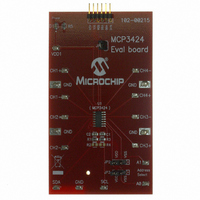MCP3424EV Microchip Technology, MCP3424EV Datasheet - Page 25

MCP3424EV
Manufacturer Part Number
MCP3424EV
Description
EVALUATION BOARD FOR MCP3424
Manufacturer
Microchip Technology
Specifications of MCP3424EV
Number Of Adc's
1
Number Of Bits
18
Sampling Rate (per Second)
3.75 ~ 240
Data Interface
I²C
Inputs Per Adc
4 Differential
Input Range
±2.048 V
Power (typ) @ Conditions
135µA @ 240sps
Voltage Supply Source
Single Supply
Operating Temperature
-55°C ~ 125°C
Utilized Ic / Part
MCP3424
Processor To Be Evaluated
MCP3424
Lead Free Status / RoHS Status
Lead free / RoHS Compliant
Lead Free Status / RoHS Status
Lead free / RoHS Compliant, Lead free / RoHS Compliant
Available stocks
Company
Part Number
Manufacturer
Quantity
Price
Company:
Part Number:
MCP3424EV
Manufacturer:
Microchip Technology
Quantity:
135
5.4
The device acknowledges the general call address
(0x00 in the first byte). The meaning of the general call
address is always specified in the second byte. Refer
to
general calls.
For more information on the general call, or other I
modes, please refer to the Phillips I
5.4.1
The general call reset occurs if the second byte is
‘00000110’ (06h). At the acknowledgement of this
byte, the device will abort current conversion and
perform the following tasks:
(a) Internal reset similar to a Power-On-Reset (POR).
All configuration and data register bits are reset to
default values.
(b) Latch the logic status of external address selection
pins (Adr0 and Adr1 pins).
5.4.2
The general call latch occurs if the second byte is
‘00000100’ (04h). The device will latch the logic
status of the external address selection pins (Adr0 and
Adr1 pins), but will not perform a reset.
5.4.3
The general call conversion occurs if the second byte
is ‘00001000’ (08h). All devices on the bus initiate a
conversion simultaneously. When the device receives
this command, the configuration will be set to the One-
Shot Conversion mode and a single conversion will be
performed. The PGA and data rate settings are
unchanged with this general call.
FIGURE 5-6:
Format.
© 2009 Microchip Technology Inc.
START
S
Figure
Note:
(General Call Address)
0 0 0 0 0 0 0 0 A
General Call
First Byte
5-6. The device supports the following three
GENERAL CALL RESET
GENERAL CALL LATCH (MCP3423
AND MCP3424)
GENERAL CALL CONVERSION
The I
‘00000000’ (00h) in the second byte.
2
C specification does not allow
General Call Address
ACK
X
X X X X X X X
Second Byte
2
C specification.
LSB
ACK
STOP
A
S
2
C
5.5
The I
device must be ‘activated’ to operate in high-speed
mode. This is done by sending a special address byte
of “00001XXX” following the START bit. The “XXX” bits
are unique to the High-Speed (HS) mode Master. This
byte is referred to as the High-Speed (HS) Master
Mode Code (HSMMC). The MCP3422/3/4 devices do
not acknowledge this byte. However, upon receiving
this code, the device switches on its HS mode filters
and communicates up to 3.4 MHz on SDA and SCL
bus lines. The device will switch out of the HS mode on
the next STOP condition.
For more information on the HS mode, or other I
modes, please refer to the Philips I
5.6
The I
protocol:
• Data transfer may be initiated only when the bus
• During data transfer, the data line must remain
Accordingly, the following bus conditions have been
defined using
5.6.1
Both data and clock lines remain HIGH.
5.6.2
A HIGH to LOW transition of the SDA line while the
clock (SCL) is HIGH determines a START condition. All
commands must be preceded by a START condition.
5.6.3
A LOW to HIGH transition of the SDA line while the
clock (SCL) is HIGH determines a STOP condition. All
operations can be ended with a STOP condition.
5.6.4
The state of the data line represents valid data when,
after a START condition, the data line is stable for the
duration of the HIGH period of the clock signal.
The data on the line must be changed during the LOW
period of the clock signal. There is one clock pulse per
bit of data.
Each data transfer is initiated with a START condition
and terminated with a STOP condition.
is not busy
stable whenever the clock line is HIGH. Changes
in the data line while the clock line is HIGH will be
interpreted as a START or STOP condition
2
C specification requires that a high-speed mode
2
C specification defines the following bus
High-Speed (HS) Mode
I
2
C Bus Characteristics
BUS NOT BUSY (A)
START DATA TRANSFER (B)
STOP DATA TRANSFER (C)
DATA VALID (D)
Figure
MCP3422/3/4
5-7.
2
C specification.
DS22088C-page 25
2
C












